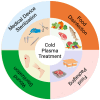Cold Atmospheric Pressure Plasma Solutions for Sustainable Food Packaging
- PMID: 38928343
- PMCID: PMC11203612
- DOI: 10.3390/ijms25126638
Cold Atmospheric Pressure Plasma Solutions for Sustainable Food Packaging
Abstract
Increasing the number of resistant bacteria resistant to treatment is one of the leading causes of death worldwide. These bacteria are created in wounds and injuries and can be transferred through hospital equipment. Various attempts have been made to treat these bacteria in recent years, such as using different drugs and new sterilization methods. However, some bacteria resist drugs, and other traditional methods cannot destroy them. In the meantime, various studies have shown that cold atmospheric plasma can kill these bacteria through different mechanisms, making cold plasma a promising tool to deactivate bacteria. This new technology can be effectively used in the food industry because it has the potential to inactivate microorganisms such as spores and microbial toxins and increase the wettability and printability of polymers to pack fresh and dried food. It can also increase the shelf life of food without leaving any residue or chemical effluent. This paper investigates cold plasma's potential, advantages, and disadvantages in the food industry and sterilization.
Keywords: bacterial inactivation; cold atmospheric plasma; food packaging; sterilization.
Conflict of interest statement
The author declare no conflict of interest.
Figures








Similar articles
-
Effects of in-package atmospheric cold plasma treatment on the qualitative, metabolic and microbial stability of fresh-cut pears.J Sci Food Agric. 2021 Aug 30;101(11):4473-4480. doi: 10.1002/jsfa.11085. Epub 2021 Feb 2. J Sci Food Agric. 2021. PMID: 33432579
-
Impact of cold plasma on Citrobacter freundii in apple juice: inactivation kinetics and mechanisms.Int J Food Microbiol. 2014 Mar 17;174:63-71. doi: 10.1016/j.ijfoodmicro.2013.12.031. Epub 2014 Jan 9. Int J Food Microbiol. 2014. PMID: 24462703
-
Effect of in-package atmospheric cold plasma discharge on microbial safety and quality of ready-to-eat ham in modified atmospheric packaging during storage.J Food Sci. 2020 Apr;85(4):1203-1212. doi: 10.1111/1750-3841.15072. Epub 2020 Mar 2. J Food Sci. 2020. PMID: 32118300
-
In-package cold plasma treatment to extend the shelf life of food.Compr Rev Food Sci Food Saf. 2024 Mar;23(2):e13318. doi: 10.1111/1541-4337.13318. Compr Rev Food Sci Food Saf. 2024. PMID: 38532699 Review.
-
Effect of novel food processing methods on packaging: structure, composition, and migration properties.Crit Rev Food Sci Nutr. 2010 Nov;50(10):969-88. doi: 10.1080/10408390903001768. Crit Rev Food Sci Nutr. 2010. PMID: 21108076 Review.
Cited by
-
Effect of Low-Temperature Plasma Sterilization on the Quality of Pre-Prepared Tomato-Stewed Beef Brisket During Storage: Microorganism, Freshness, Protein Oxidation and Flavor Characteristics.Foods. 2025 Mar 22;14(7):1106. doi: 10.3390/foods14071106. Foods. 2025. PMID: 40238206 Free PMC article.
References
-
- Shelar A., Singh A.V., Dietrich P., Maharjan R.S., Thissen A., Didwal P.N., Shinde M., Laux P., Luch A., Mathe V. Emerging cold plasma treatment and machine learning prospects for seed priming: A step towards sustainable food production. RSC Adv. 2022;12:10467–10488. doi: 10.1039/D2RA00809B. - DOI - PMC - PubMed
-
- Koulik P., Begounov S., Goloviatinskii S. Atmospheric plasma sterilization and deodorization of dielectric surfaces. Plasma Chem. Plasma Process. 1999;19:311–326. doi: 10.1023/A:1021604027855. - DOI
-
- Boeckmann L., Schäfer M., Bernhardt T., Semmler M.L., Jung O., Ojak G., Fischer T., Peters K., Nebe B., Müller-Hilke B. Cold atmospheric pressure plasma in wound healing and cancer treatment. Appl. Sci. 2020;10:6898. doi: 10.3390/app10196898. - DOI
-
- Kotov D., Krivenchuk D., Osipov A., Patseev S., Aksiuchyts A., Ponomarenko G., Kulchitsky V. Cold Atmospheric Plasma Treatment of Medical Devices. Biomed. J. Sci. Tech. Res. 2019;22:16745–16749.
Publication types
MeSH terms
Substances
Grants and funding
LinkOut - more resources
Full Text Sources

